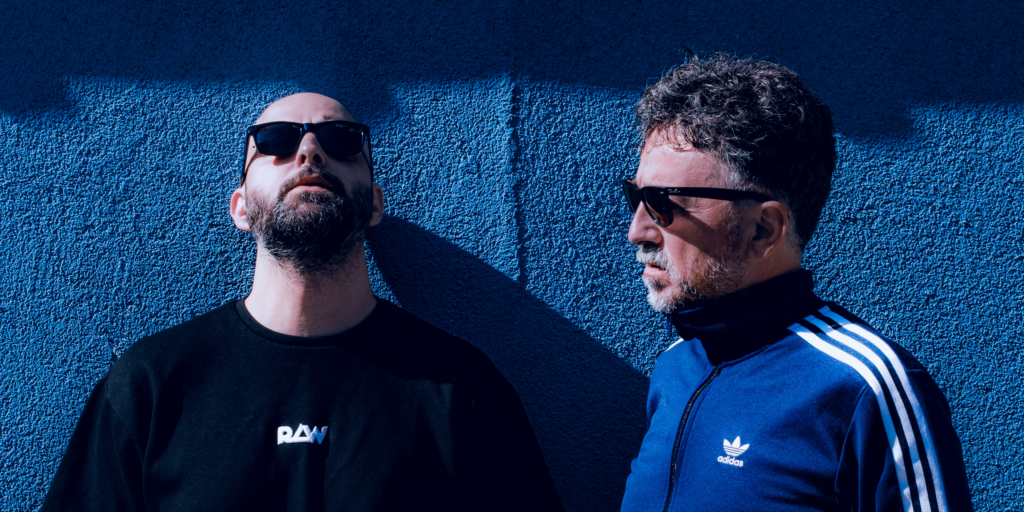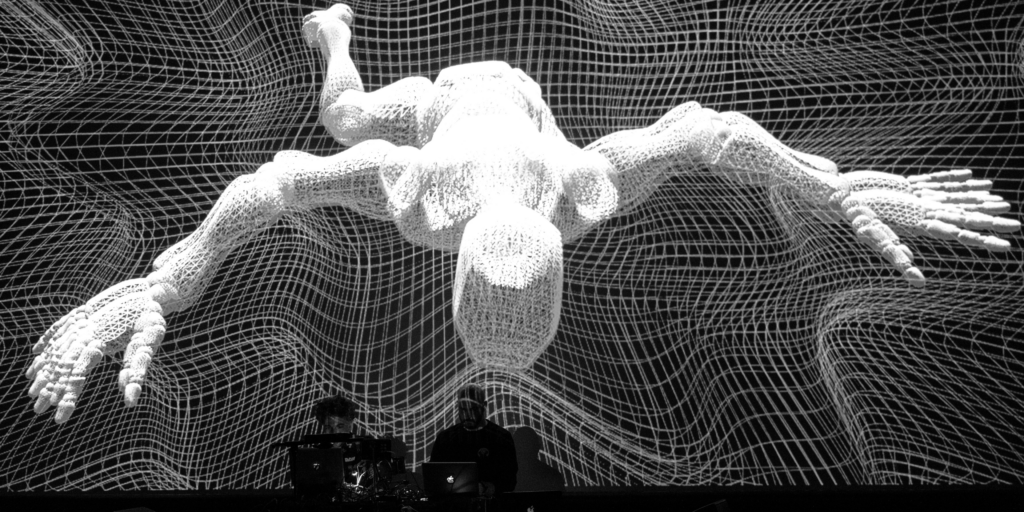
⏳3.12.2023
In this exclusive interview, we speak to live-coding duo RAW about their respective journeys into the creative coding field, how their unconventional path has evolved, as well as their advice for creatively motivated software engineers.
The live audio-visual performance duo is comprised of Selçuk Artut & Alp Tuğan who work together in real-time to creative hypnotic visuals and complex algorithmic melodies. The pair perform internationally and we are honoured to get the chance to talk to them and provide some inspiration for our applicants.

At 42 Berlin, our mission is to make high-quality software engineering education accessible and free. We also hope to expand the conventional horizons for coders. To see RAW pushing the boundaries of the field of tech is a huge inspiration. Could you give us an insight into your journey within the field and what inspired you to focus on the bridge between tech and the arts?
Selçuk: We both had careers as musicians in the past. Let me start by talking on my behalf. I played bass guitar for so many years and had a professional career with a post-rock band named Replikas. Despite my engagement with music, dealing with computers has always been around me on various occasions. I was playing computer games on my C64 when I was young and I wanted to program my own stuff and build my custom hardware designs. Back then, I was programming in various languages for different outcomes. Either I was building a website or trying to write software to control hardware. With the help of a computer, you can easily move between several disciplines seamlessly. My enthusiasm moved me in a direction to code to create generate art. For example, in 2010, I was making generative music by rendering seismographic data for a theater project with Rimini Protokoll from Germany. Such experiences sparked my interest in exploring the intersection of technology and creativity. I began experimenting with algorithms and coding techniques to create visual and auditory experiences that pushed the boundaries of traditional art forms. This fusion of programming and art became a driving force in my creative journey, leading me to constantly seek new ways to express myself through code.
Alp: Growing up as a child in the 90s, I was fortunate enough to experience technology in its heyday when it was more open to customisation. Back then, if your Atari console’s joystick malfunctioned, you could quickly fix it with a screwdriver from the toolbox. Similarly, if your VHS player stopped working, you could clean the magnetic reader and resume watching your movie. Finally, getting my first computer in high school was a significant turning point in my life. I spent hours trying to master computer graphics using third-party software tools that I installed from computer magazine disks. One of my favourite applications was Winapp’s audio-reactive music visualizer, which was nothing short of magical to me. I learned Fortran, my first programming language, during my university years. Later on, in the early 2000s, I began experimenting with Adobe Flash’s programming language Action Script 3.0 to create visuals and discovered generative art. Moreover, I created custom audiovisual applications using Cycling’s MAX/MSP/Jitter, one of the first tools available for this purpose. I am intrigued by the idea of using analogies to explain complex concepts or events to others. Programming provides me with an opportunity to do so. Through the use of digital data, I can express my ideas and create audiovisual compositions. This approach enables me to tell stories with captivating and engaging analogies.
RAW’s performances and albums are filled with live-coded algorithmic melodies,
alongside unique coded visuals. There is nothing quite like this in the respective
fields of music or tech. What has your experience been like of integrating this art-form in public environments? Where do you see live-coding’s mission in the art and tech stratosphere?
Our inaugural concert was performed in a gallery. The venue was completely occupied, and attendees were extremely eager to view our live audiovisual performance. However, persuading individuals that the music was being generated spontaneously through code- writing took some time. Despite the fact that we were projecting the code onto the audience, it was perceived more as a visual component than as the primary element for composing the musical experience. Later, as we participated in an increasing number of events, individuals began to comprehend what we were attempting to say. Then, the dilemma of whether or not to release an album arose. Because the audiovisual experience that we deliver fluctuates
considerably with each performance. Despite this, we have released albums, EPs, and singles, and the number of our followers continues to grow. We relish the opportunity to perform in public spaces whenever possible. We discovered that audiences enjoyed witnessing the live creation of the audiovisual compositions during our performances. Even if the audience lacks prior experience in code reading, they are able to comprehend the implementation of the procedures and their completion. The mission of live coding in the realms of art and technology is multifaceted and influential. By ensuring that programming is both accessible and engaging, this initiative aims to democratize technology and empower artists to actively engage in the process of creating digital art and music. Promoting community and collaboration, the practice facilitates the exchange of code in real time and promotes collective learning. Furthermore, it acts as an impetus for the advancement of novel interfaces, exerting an impact on the wider domain of human-computer interaction. In its entirety, live coding exerts a significant influence on the
trajectory of digital innovation, challenging the limits of traditional artistic and technological methodologies.
How has your craft evolved since you began? What learnings have you gained along the way?
Our musical sensibilities and experiences profoundly shape our aesthetic. Engaging in the exchange of preferred songs amongst ourselves fosters a shared understanding of musical preferences, which we appreciate. Experimenting with and blending various sounds is typically our primary starting point. Although articulating our individual musical styles remains a formidable task, the process of composing our own music also facilitates the development of a curatorial mindset towards our craft. As we were engaged in the production of the new album, we were confronted with dire sociological and political catastrophes. These factors influence our perspective on music, and ultimately, we were enthusiastic about creating an album devoid of any musical content. This method subsequently inspired us to combine noise, sound art, and music in order to develop a solid compositional strategy. As an illustration, the Diachronic track from the W.A.R. album provides a nearly continuous auditory immersion through the use of well-balanced noise textures. The aim was to challenge traditional notions of music and push the boundaries of sonic experimentation. By incorporating noise and sound art into our compositions, we sought to evoke emotions and provoke thought in ways that traditional musical elements alone could not achieve. The Diachronic track exemplifies this approach, captivating listeners with its immersive and carefully crafted layers of noise textures that create a unique auditory experience.
What tools and resources are invaluable to you?
During our investigation into live coding methods, we reached the consensus to utilize the Supercollider as a tool for sound development. However, implementing your ideas rapidly proved to be quite challenging, and expressing experimentation was strictly institutionalized. Furthermore, as soon as we began to perform in front of larger audiences, expectations escalated and progress in Supercollider development was extremely sluggish. We quickly transitioned to utilizing Sonic Pi; however, we found its musical aesthetics to be less than ideal. We subsequently switched to utilizing Tidalcycles. This development greatly affected us, as it enabled us to synchronize two computers with exceptional precision. We are both responsible for creating music and visuals simultaneously. Attempts were made to generate visuals through live coding at one point, but that endeavour did not last for very long. Our visual elements are composed of Openframeworks precompiled codes that respond to audio via real-time frequency analysis.
What advice would you give to budding software engineers who want to follow this
more artistic route?
When it comes to creative coding, there is a kind of knowledge that is hard to put into words. It can be thought of as tacit knowledge, similar to trying to explain how to ride a bicycle without actually doing it. To truly understand and learn creative coding, one must practice and apply theoretical concepts. Merely reading books on how to ride a bicycle will not make you an expert on riding a bike. Falling down is a natural part of the learning process, as it allows for the development of balance and coordination. While sketchbooks and note-taking apps can help generate ideas, implementing them is crucial. Those interested in creative or live coding can gain valuable insight by joining forums, reading daily posts, and asking questions of others within the community. As a beginner, contributing to the documentation pages of these application frameworks can provide hands-on experience. Ultimately, the only way to improve your skills is to practice and seek help when needed. Don’t be afraid to make mistakes, as they are an opportunity to learn and prevent them in the future.
Check out RAW’s recent performance at Sonar Istanbul, as well as their latest album entitled W.A.R (We Are RAW)
42 Berlin 2023